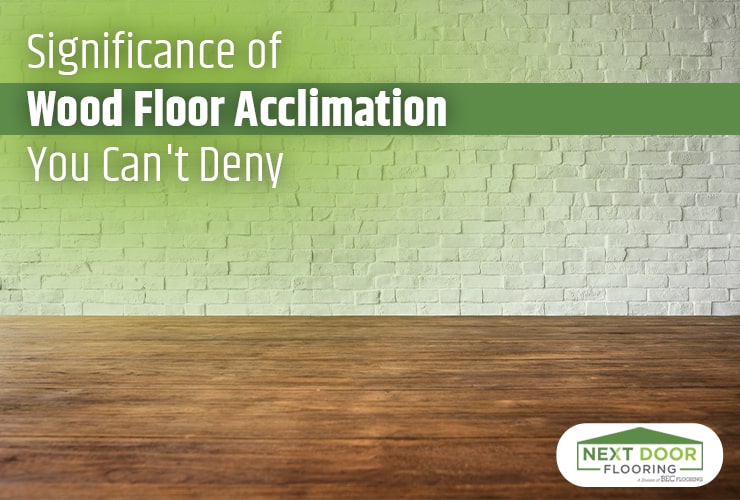Overview
Wood’s hygroscopic nature makes it absorb moisture and release it in response to Alpharetta, GA’s humid and subtropical climate. Due to this climatic condition, wood floor acclimation is a popular choice for locals. They can adjust to the moist environment and reduce the risk of expansion, contraction, warping, or buckling.
Next Door Flooring has compiled this ultimate guide on the significance of wood floor acclimation. It includes factors to consider when acclimating wood flooring, recommended methods, and best practices. Moreover, this blog will also take you through the benefits of wood floor acclimationand the process of acclimating engineered wood flooring. How long do wood floors need to acclimate? Read on to learn:
Understanding Wood Floor Acclimation
Georgia’s humid environment necessitates acclimating wood flooring with care and precision. With weather fluctuations, wood can expand and contract, causing damage to the structure and intactness of wood floors that stay intact for a specific duration. That’s where acclimation comes in. With the help of wood floor acclimation, wood floors reach an equilibrium level according to their surrounding areas, which reduces various risks after installation. When you acclimate wood flooring properly, it’s stability and timeless beauty stay intact.
The Process of Acclimating Wood Flooring
To be precise, acclimating means allowing the wood to adjust and settle down according to its environment. This will enhance the longevity and stability of wood floors, and their shine and beauty will be preserved longer. Acclimating wood flooring is a must for humid and moisturized locations like Alpharetta, GA, where the temperature and moisture difference between wood and its environment are high. Let us take you through the step-by-step process of acclimating wood flooring:
Purchasing the Wood Flooring
Buy the wood flooring material you need to install. However, one thing you need to care about is storing and protecting moisture during transportation or storage.
Site Preparation
To install wood floors, ensure the site and its environment are ready. This may include determining the completion of subfloor preparation, such as cleaning, leveling, and moisture barrier installation.
Wood Flooring Installation
Open the wood flooring boxes, remove any wrapping, and let the air pass. Now you are ready to get started on the acclimation process. Put the wood flooring on the installation site and install it. You must stack the boards loosely and allow the air to circulate through each panel. Moreover, you must ensure that these boards are not in direct contact with concrete or the subfloor to avoid transferring moisture.
Monitor Temperature and Humidity
Once you are done with the installation, use a thermometer and hygrometer to precisely measure the temperature and humidity levels, respectively, in the installation area. Record these readings regularly during the acclimation process.
Allow Sufficient Time
The acclimation process needs sufficient time to settle down properly, which we will discuss in a later section. However, it depends on various factors such as climatic conditions, species of wood, length and width of wood boards, and more.
Maintain Ideal Conditions
Maintaining ideal conditions throughout the acclimation process is crucial to getting better results. This may include checking temperature and humidity levels and making them consistent with normal living conditions.
Factors to Consider When Acclimating Wood Flooring
There are many factors that you must consider during wood floor acclimation. Let’s have a sneak peek at them:
Climate
As mentioned above, Georgia has a humid climate that plays an essential role in the installation. Different regions have various moisture content ranges and temperature fluctuations, directly affecting the wood flooring.
Seasonal Variations
Seasonal variations can affect the length of wooden boards, as they can expand or contract depending on temperature fluctuations. Therefore, when acclimating the wood flooring, consider the seasonal variations.
Subfloor Moisture
You must consider and address the subfloor moisture content level to prevent moisture damage or any other relevant problem in the long run.
How Long Do Wood Floors Need to Acclimate?
Have you been searching for “How long do wood floors need to acclimate” on Google? Acclimation durations can vary from area to area. However, in Alpharetta, GA, you must spend 2 to 7 days acclimating the flooring so it can be subtle according to its external environment. It also depends on the wood species you choose, and you can also seek suggestions from flooring manufacturer guidelines. During this period, the wood flooring is stored in the room where it will be installed, allowing it to gradually adjust to the temperature and humidity levels of the space.
How to Acclimate Engineered Wood Flooring
Engineered wood flooring is less prone to expansion or contraction due to its nature, but you still need to consider acclimation for a more stable and long-lasting flooring installation. The typical process to acclimate engineered wood flooring includes reading the manufacturer’s instructions, site preparation, unboxing the flooring, allowing acclimation time, maintaining proper conditions, monitoring the moisture content, keeping a check on the readings, etc.
Benefits of Proper Wood Floor Acclimation
Proper wood floor acclimation comes with more benefits than you can imagine. Here are some of the many benefits of wood floor acclimation:
Minimizes Dimensional Changes
Wood is a naturally occurring substance that can absorb or release moisture depending on the humidity levels in its environment. To ensure that your wood flooring remains stable after installation, it’s important to acclimate it to the surrounding conditions. This will allow it to reach an equilibrium moisture content with its environment, which can help prevent common issues like expansion, contraction, cupping, or warping.
Prevents Installation Issues
Before installing wood flooring, it’s important to acclimate the material to the environment. This process helps identify any potential issues that may arise during installation. If the wood exhibits significant changes, such as excessive expansion or contraction, it may indicate that the environment is unsuitable for installation. You can avoid future complications by addressing any underlying issues or adjusting the installation plans.
Enhances Long-Term Stability
Proper acclimation helps the wood flooring adjust to the humidity levels in the space, reducing the risk of future problems. This will enable the flooring to stabilize and adapt to its new surroundings, ensuring long-term stability and decreasing the likelihood of problems like buckling, gaps, or other structural issues.
Conclusion
This blog highlighted the vital role of wood floor acclimation, its significance, and its process. Moreover, we understood how long wood floors need to acclimate and learned about acclimating engineered wood flooring. Besides this, we explored the factors and benefits to consider during the wood floor acclimationprocess.

